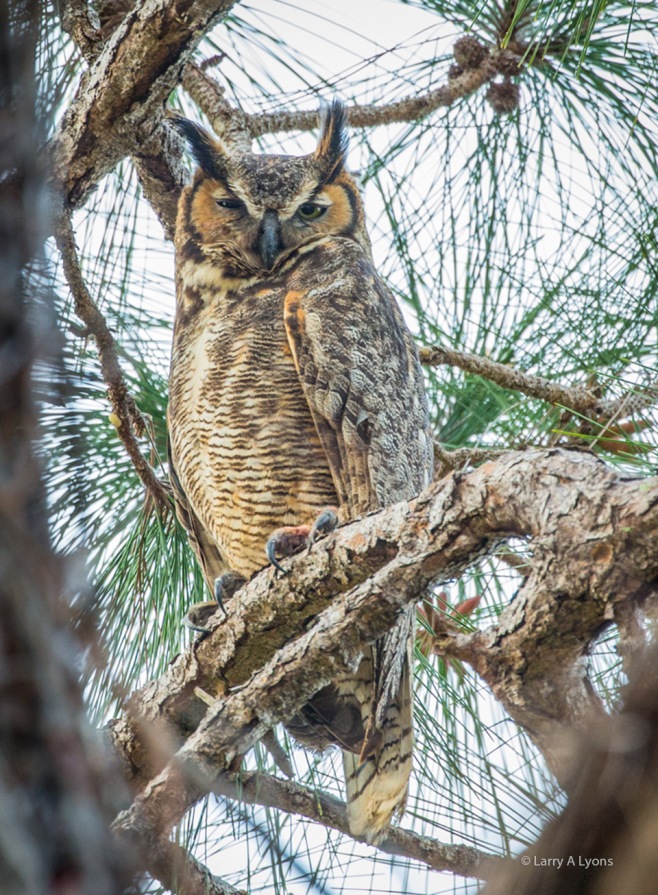Spring Has Sprung: Birds of Prey
This is the second post of a three part series of a Florida field trip that this photographer co-coordinated for the South Jersey Camera Club members for the purpose of photographing birds and their behavior. The field trip was conducted over a five-day period in the beginning of March. The first post entitled, ‘Spring Has Sprung: Busy, Busy Birds’, visited the Venice Rookery with an amazing diversity of birds courting, mating and raising offspring. This post travels to various locations in southwest Florida to photograph birds of prey nesting and caring for their offspring.

‘Bald Eagle’ © Larry A Lyons
The Bald Eagle is another success story on the importance of banning harmful chemicals, such as the pesticide known as DDT; enacting laws such as the federal ‘Endangered Species Act’; and providing appropriate measures of wildlife management. In Florida there were only 88 active nests in 1973. Now there are more than 1,300 nests documented as a result of all of these initiatives.
One of these nests is situated high up in a tree in the northern section of Fort Meyers, Florida. Adult ‘Bald Eagles’, known as Ozzie and Harriet, have been coming to this nest since 2006 residing in the nest between the months of October and May. This eaglet was stretching its wings waiting its turn to be fed.

‘Can I Fly Yet?’ © Larry A Lyons

‘Feeding The Eaglets’ © Larry A Lyons
‘Burrowing Owls’, no bigger than 10 inches (25 cm) in height, live underground in burrows. They dig out tunnels in sandy soils often within residential communities, particularly vacant lots preferring areas with low ground cover. Burrows extend for 4 to 8 feet (1.2 to 2.4 m) underground. This pair of owls was guarding its burrow.

‘No Trespassing’ © Larry A Lyons
The Florida burrowing owl is classified as a “species of special concern”. This means burrows, owls, and their eggs are protected from harassment and/or disturbance by state law.

‘Burrowing Owl On Watch’ © Larry A Lyons
The installation of T-perches near the owl burrows is often provided. These perches provide the owls with an elevated view that aids in looking out for predators. The T-perches also make the burrows visible for operators of lawn mowers.

‘Watching Over Burrow’ © Larry A Lyons
Unlike other owls, Burrowing Owls are active during the day. They have a diversified diet feeding on small mammals (moles and mice), insects, birds, amphibians and reptiles.

‘On The Prowl’ © Larry A Lyons
This wise old ‘Great Horned Owl’ was watching over an owlet living in this tree. Two nests of these owls were observed within a suburban community of Cape Coral that was no more than two blocks apart. It is one of the most common owls in North America. They live in a broad range of habitats from deserts, forests, tropical rainforests, cities, parks and suburbs. Like the burrowing owl, it has found a way of adapting to suburban sprawl.

‘The Wise One’ © Larry A Lyons
Great Horned Owls take life-long mates and will raise the young together. It does have a varied diet that can include small to medium sized mammals (foxes, rabbits, raccoons, rodents, etc.), amphibians, birds, fish and reptiles. This owlet is only a few weeks old and still covered with downy feathers.

‘Owlet’ © Larry A Lyons
The osprey has become the symbol of how nature can recover from environmental atrocities. Osprey populations were decimated from the 1950’s to the 1970’s because of the widespread use of an insecticide, known as DDT. Once DDT was finally banned in 1972, recovery of the osprey population began. A previous post entitled, ‘The Osprey Comeback’, provides more information about the how DDT caused the extermination of the osprey populations. The biology and reproduction cycle of the osprey is also provided in this previous post.

‘Osprey Portrait’ © Larry A Lyons
The ospreys were quite active in building their nest. This nest was situated on an osprey platform in the Ding Darling Refuge in Sanibel Island and nesting begins as early as March. The male ‘Osprey’ brought the remainder of a fish to the female who was attending to constructing the nest. Ospreys mate for life and often return to the same nest year after year.

‘Room Service’ © Larry A Lyons
Stay tuned for the final post of this series that will visit birds and other wildlife at Ding Darling Wildlife Refuge and the Corkscrew Swamp Sanctuary.
6 Responses to “Spring Has Sprung: Birds of Prey”
I love them all, but THE WISE ONE has captured my heart
Larry, this is splendid, comprehensive work. I can’t help wondering if Cornell’s excellent ornithology lab would be interested in your work. Their home page is at http://www.birds.cornell.edu/Page.aspx?pid=1478
GREAT images Larry
[…] an amazing diversity of birds courting, mating and raising offspring. The second post entitled, ‘Spring Has Sprung: Birds of Prey’, traveled to various locations in southwest Florida to photograph birds of prey nesting and caring […]
[…] Spring Has Sprung: Birds of Prey […]
Nice photos